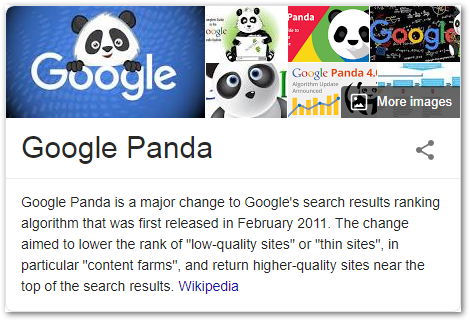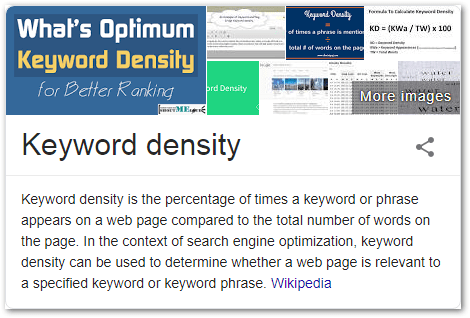In marketing you have to take advantage of your opportunities, sometimes requiring a flying jump. Changes in consumer behavior after the pandemic are encouraging today’s leap in terms of search engine optimization (SEO). As a marketing expert, you now have two years of searching the internet under the influence of a pandemic. This means you should update your keyword strategy in online content … now!
In doing so, you will find some measurement techniques that face a new order in the pantheon of marketing analytics. Keyword density is a tried and true revision of how often a keyword appears on a page. Now more sophisticated tools raise the question of whether keyword density is the right value for a business strategy. This post will answer that by looking at the pros and cons of that value and how you should rethink density analysis for an SEO strategy.
The View of Keywords in SEO History
Contents
- 1 The View of Keywords in SEO History
- 2 The Opportunity to Revitalize Keywords and SEO Metrics
- 3 Selecting Keywords for a Post-Pandemic Customer Experience
- 4 Creating a Keyword Map
- 5 What is a good keyword density?
- 6 How can we optimize a SEO friendly URL?
- 7 Does keyword density matter in 2021?
- 8 What is Fivlytics?
- 9 Are long tail keywords better?

Keyword analysis is a long-standing tactic for planning the right word association that links online search queries from potential customers to web pages or application pages that respond to those queries. Marketers use SEO to manage that link by measuring keyword density and examining the position of words within a website. Achieving a keyword density of 1% to 2% was an assurance that the website would attract the target audience using that keyword in a search query.
Fast forward to 2022. Under the shadow of gradual algorithmic refinements of search engines to include more natural use of speech, SEO strategists now need to consider more dynamic associations that link pages to search engine results. To meet this need, advanced SEO tools have introduced ways to draw more sophisticated conclusions from keyword density metrics. For example, Yoast introduced derivative metrics, the density of key phrases. The key phrase is two or three closely related words, such as hot cider. This phrase should reflect words that are naturally used in conversation.
Advances in website search and design have reduced the value of analyzing reporting on individual SEO metrics over time. One metric can indicate behavior, but analysts need to relate that information to a larger picture of online customer behavior. This is why the value of some metrics, such as the homepage dropout rate, which I covered in a previous post, is considered less valuable or unnecessary.
So while keyword density is still a valuable indicator for an SEO strategy, it only explains the word usage ratio on a given page. These days, marketers are cross-examining multiple pages to get a picture of a website’s search performance.
Marketers create more content, driving more page creation. Consequently, their content faces the potential cannibalism of keywords, the potential for sites to compete with each other for search query traffic from a given keyword. They need tactics with metrics that can help explain the rationale for choosing a word, not a revision. Why words are chosen and how they fit into the design of your site’s content is what makes your site visible to search queries.
Related article: How to improve SEO through keyword mapping
The Opportunity to Revitalize Keywords and SEO Metrics

The impact of COVID-19 brings an opportunity to revitalize keyword density values into a meaningful strategy. The pandemic has introduced new considerations about how people seek information, such as supply chain problems that have triggered accumulated demand for products and services.
As a result, people explore potential future purchases more often than the “old normal”, bringing more opportunities for your online content to educate prospective customers who will come to your company to discuss purchases. The Search Engine Journal noted that interest in search increased during the pandemic, leading to greater interest in reviewing and updating content among companies looking to remain relevant to new search behaviors.
If you’re responsible for your site’s SEO, you now have the opportunity to test two-year search behavior to examine past search trends for changes in keyword usage or the introduction of new phrases. The changed behavior will determine the choice of keywords and support tactics for your SEO strategy.
Related article: 7 tips for choosing the right SEO agency
Selecting Keywords for a Post-Pandemic Customer Experience

So what do you do to make a good choice? You start by comparing the keywords in your content with recent search trends, and then decide how to update your content. Your choice of keywords should meet the specific needs of your audience. What phrases do they use while spending time online? What problems do they keep mentioning?
You then examine which keyword queries attract people to your site. This can reveal which pages need to be checked for keyword density.
For example, in the Performance Report in the Google Search Console, you can filter clicks and impressions for each page by keyword. This can give an overview of what has attracted people to the page of your website and signal what is not of interest.
One downside to the Google Search Console is that you can receive variations of phrases sorted into reports. Some words and phrases appear more than once, but are treated separately. For example, in one of Ziman’s older blog posts, the phrase JavaScript repeatedly appears in different forms of the phrase “What is a JavaScript bunch?” This variation can create extra effort around what is essentially one common query.
A workaround for this is to import GSC data into an R programming script. You can then use keyword testing functions per page.
To do this, you would use the SearchconsoleR library. SearchconsoleR uses the Google Search Console API to import data into R programming. You can then apply additional libraries to sort the data.
In the examples below, I created a few lines to count how many times the keyword “analytics” appeared on the reported pages and other code to display the sample.
Creating a Keyword Map

Of course, too frequent use of keywords on a website remains a big red flag. Search engines find a very high percentage of keyword density full of keywords, excessive use of phrases in blog articles or pages. Most marketers know that.
Finally, you should use keyword density to identify the use of your targeted keywords on a given page and compare your results to the words people use in their search. You can also use it to compare pages that use the same keywords, and then create a keyword folder to choose the best content and metadata customizations. You can learn more about keyword mapping in this post about keyword mapping.
There is another more advanced keyword analysis technique called Term Frequency – Inverse Document Frequency (TF-IDF). This is essentially an algorithm that examines the number of words in relation to several pages within a given document. Most early examples show how to measure the frequency of words in the text of a novel or journalism. But thanks to APIs, analysts are learning how to apply the same analysis to social media posts and other digital texts. In fact, TF-IDF is the basis for semantic search in search engine algorithms. TF-IDF can be a great technique for understanding not only the frequency of keywords, but also the semantics of its use.
The way you talk to your customers through your content is paramount. Making good keyword decisions that link metrics like keyword density to a higher SEO strategy may seem like a small start, but it’s a very smart start to measure search … the start of a user experience journey.
What is a good keyword density?

Most SEO experts believe that the ideal keyword density is around 1-2%. This means that the target keyword appears approximately one to two times per 100 words. At this speed, the keyword appears enough times to show search engines what the page is about without engaging in keyword stuffing.
What is the average keyword density? As mentioned above, the average keyword density for an entire page tends to drop by about 30%. This number can go up or down depending on what industry you are writing in. For example, there would be less accessible text if I tried to write about ‘collector’s items’ on my head instead of general information about them.
Does keyword density still matter?
The short answer is yes. It really matters. In fact, there is a term for this called keyword density.
Do keywords matter anymore?
Read why SEO keywords should be the foundation of your content to meet and meet the needs of users. Are keywords still important for search engine optimization (SEO)? Are keywords important to Google at all? Short answer: Absolutely.
Is keyword density still important 2020?
Yes, keyword density is still important. Today, you hear much less about it in SEO circles, but keyword density remains an essential part of good SEO. The fact is that other SEOs have started to neglect this, simply creating an opportunity for those who are willing to make an effort to write well-optimized content.
Is keyword density still important 2022?
So now it’s 2022 and some people are wondering if keyword density is a factor in SEO ranking in Google search. The answer is still no, according to John Mueller, a Google search agent. This appeared on Reddit just days before the end of 2021.
What is the keyword density in 1000 words?
All you have to do is divide the number of times your keyword appears on the page by the number of words on that page. For example, if you mentioned your keyword ten times in a 1000-word article, your density would be 1%.
What is keyword density example?
Keyword density tells you how often a search term appears in your text relative to the total number of words it contains. For example: if a keyword appeared three times in a 100-word text, the keyword density would be 3%.
What is keyword density answer?
Keyword density is the number of times a particular keyword is used on a content page. It is usually expressed as a percentage of the total number of words on a page.
How many times do you use keywords in a 1000 word article?
Keyword Density This means that in a 1000-word blog post, you want the exact keyword to be mentioned four times. I usually see this concept used on low ghost writing platforms, such as Textbroker.
How can we optimize a SEO friendly URL?
How to create a custom SEO URL in 6 steps
- Use a keyword in the URL. Include the correct keyword in the permanent part of the URL. …
- Do not include special characters. …
- Link the URL to the page title. …
- Say unnecessary words. …
- Avoid automatic numeric labels. …
- Omit stop words if you want.
What is an SEO friendly URL structure? What are SEO friendly URLs? SEO friendly URLs are URLs that are designed to meet the needs of users and search engines. In particular, SEO-optimized URLs are usually short and rich in keywords.
Does keyword density matter in 2021?
The best keyword density in 2020 was 0.5% to 1% and we expect it to stay the same in 2021. This means that the keyword appears 3 to 6 times in a 600-word article or 5 to 10 times in a 1000-word article. words. The reason why a keyword density of 0.5-1% is best is to prevent unnatural keyword stuffing.
Is keyword density still important? The short answer is yes. It really matters. In fact, there is a term for this called keyword density.
Do keywords matter in 2021?
In 2021, keywords are still important and useful in SEO, but they are not the most important factor. This is because SEO is far more complex than putting keywords on a page. Also, since SEO is always changing with search engines constantly updating algorithms, marketers need to change the way they use keywords.
Is SEO relevant in 2021?
So, is SEO still a good investment in 2021 ?! Short answer: YES! SEO is more important than ever! It is still one of the most powerful digital marketing strategies that drive long-term results.
Do keywords matter anymore?
Read why SEO keywords should be the foundation of your content to meet and meet the needs of users. Are keywords still important for search engine optimization (SEO)? Are keywords important to Google at all? Short answer: Absolutely.
Is keyword density still important 2020?
Yes, keyword density is still important. Today, you hear much less about it in SEO circles, but keyword density remains an essential part of good SEO. The fact is that other SEOs have started to neglect this, simply creating an opportunity for those who are willing to make an effort to write well-optimized content.
Is keyword density still important in 2022?
So now it’s 2022 and some people are wondering if keyword density is a factor in SEO ranking in Google search. The answer is still no, according to John Mueller, a Google search agent. This appeared on Reddit just days before the end of 2021.
Why is keyword density important?
Keyword density is a fundamental aspect of SEO on a page. When used properly, it can help attract search engines and increase page visibility on search engine results pages (SERPs). When ignored, it can prevent a page from ranking or even result in a search penalty, removing it from the SERP altogether.
What is Fivlytics?
Fivlytics is an auxiliary tool for Fiverr sellers. This provides keyword analysis, performance ranking verification and SEO tools for fiverr. Our stand-alone algorithms analyze data from fiver related to buying, selling, and SEO to generate unique data to find rankings and keyword insights.
Are long tail keywords better?
Focusing on long lasting keywords is a great SEO tactic. Long keywords are keywords or key phrases that are more specific – and usually longer – than the more commonly used keywords. Long keywords generate less search traffic, but will typically have a higher conversion value because they are more specific.
Are long-tail keywords still relevant? Long keywords. Long keywords have been used by experts who have been offering SEO services for some time, and they still work. Used properly, it can be a compelling way to take advantage of high-end search traffic.
Why long tail keywords are better?
Focusing on long lasting keywords is a great SEO tactic. Long keywords are keywords or key phrases that are more specific – and usually longer – than common keywords. Long keywords generate less search traffic, but will typically have a higher conversion value because they are more specific.
Which is better long-tail or short-tail keywords?
When searching for more specific results, web users tend to enter a longer query (i.e. a long-tailed keyword) into Google or another search engine to get more relevant results. Conversely, if they search only for a general topic, they are more likely to enter a short query of one or two words.
What is the benefit of using long tail keywords?
Long keywords generate less search traffic, but will typically have a higher conversion value because they are more specific. They allow you to gradually get more traffic to your site and to find a new and motivated audience.
Why should you target long tail keywords?
By targeting long-tailed keywords, your website can rank for keywords that have less competition and that are highly relevant to your potential customers. The goal is to find specific keyword combinations and gradually optimize your content over time to improve your rankings.
What is a disadvantage of long tail keywords?
Long tail keywords have a small search volume The small search volume of long keywords is the only significant drawback of this type of search term.
What is an advantage of short tail keywords?
Attracting more website visitors to your website is the main advantage of targeting short keywords in your SEO strategy. These broader keywords are also much more competitive.
What is the benefit for long-tail keywords?
Long keywords generate less search traffic, but will typically have a higher conversion value because they are more specific. They allow you to gradually get more traffic to your site and to find a new and motivated audience.
Which is better long-tail or short tail keywords?
When searching for more specific results, web users tend to enter a longer query (i.e. a long-tailed keyword) into Google or another search engine to get more relevant results. Conversely, if they search only for a general topic, they are more likely to enter a short query of one or two words.
Should I use long-tail or short-tail keywords?
When searching for more specific results, web users tend to enter a longer query (i.e. a long-tailed keyword) into Google or another search engine to get more relevant results. Conversely, if they search only for a general topic, they are more likely to enter a short query of one or two words.
What is an advantage of short tail keywords?
Attracting more website visitors to your website is the main advantage of targeting short keywords in your SEO strategy. These broader keywords are also much more competitive.
Why use short tail keywords for SEO?
In online advertising, short tail keywords are more competitive. In other words, more advertisers bid to place ads on the most popular search engine results pages for shorter, more common phrases. Pinning ads to long keywords can lead to improved ROI for your SEO.
